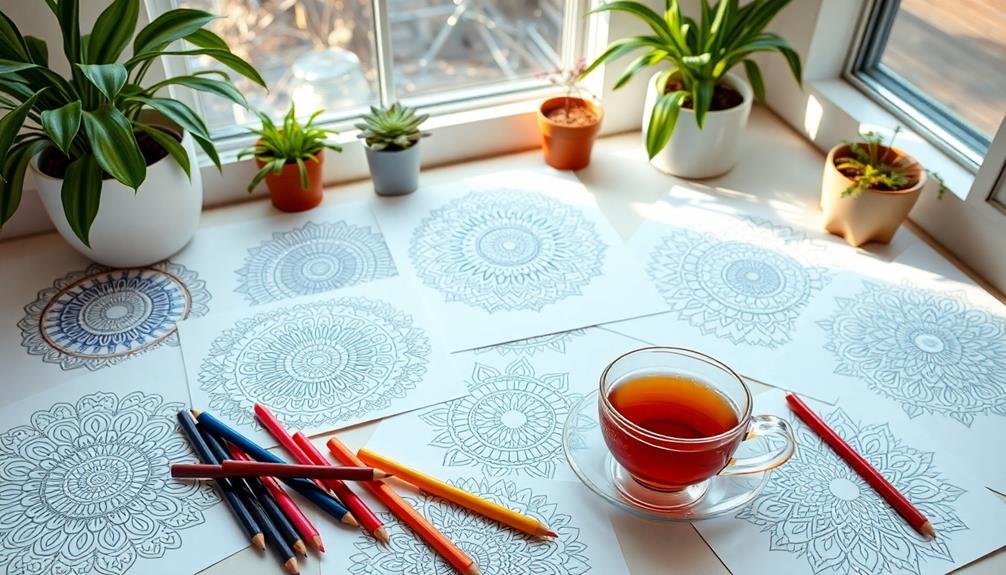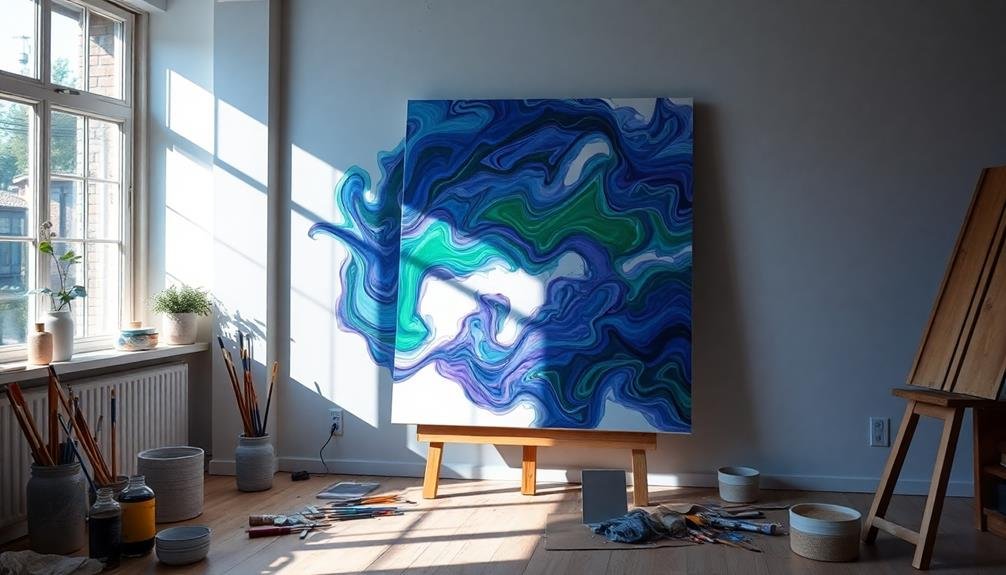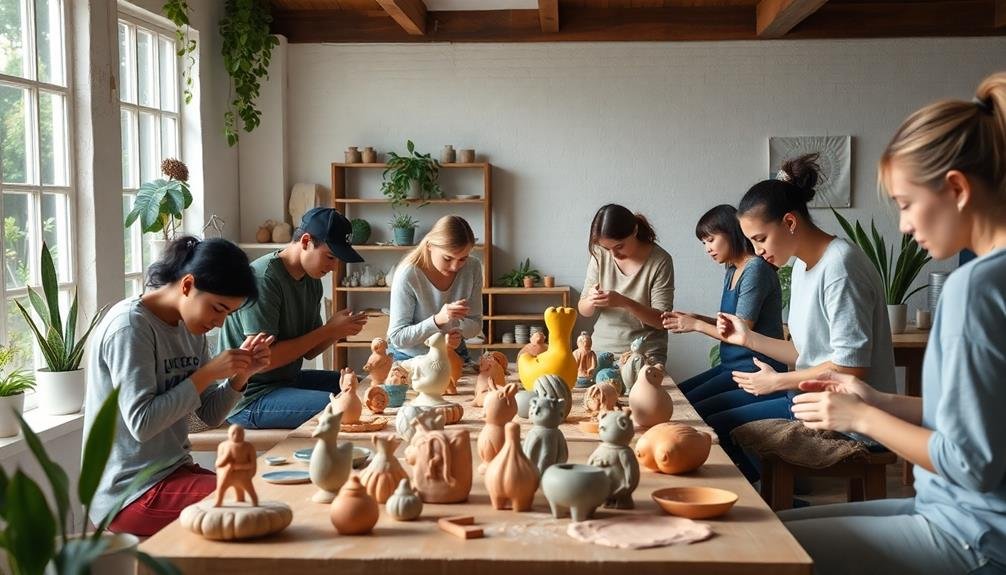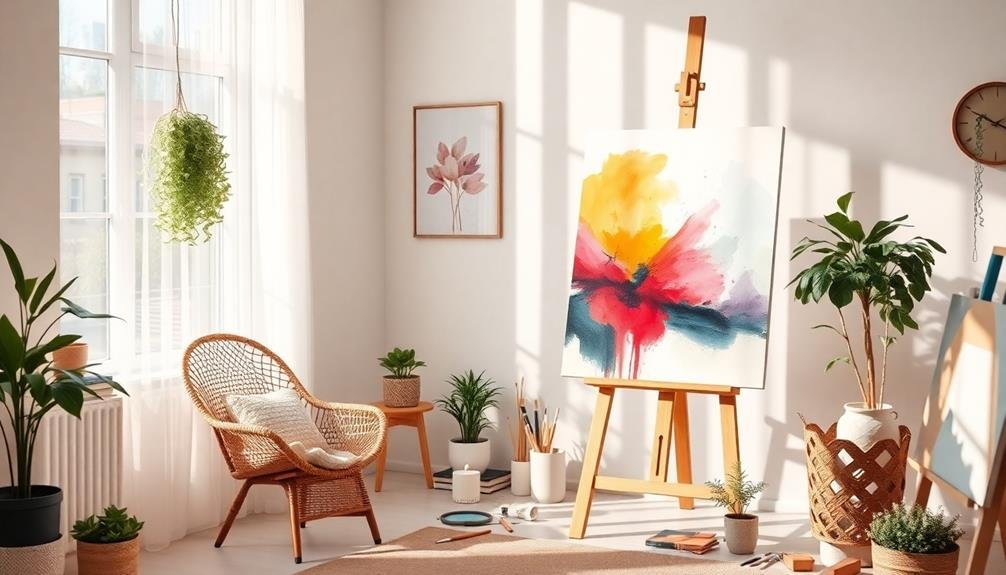If you're looking to ease anxious minds through art, try these five techniques. Mindful coloring can help you immerse yourself in the moment, promoting relaxation. Creative journaling allows for self-expression, whether through stream-of-consciousness writing or visual art. Abstract painting serves as a robust release for pent-up emotions, while collage-making encourages you to gather images that resonate with your feelings. Ultimately, sculpture and clay therapy provide a hands-on way to mold your thoughts into tangible forms. Each technique offers unique benefits, so explore them further to find what resonates best with you.
Mindful Coloring Practices

Mindful coloring practices offer a unique blend of relaxation and creativity, allowing you to immerse yourself in the present moment. This technique encourages you to focus on the act of coloring, engaging your senses and calming your mind. As you choose colors and fill in patterns, you'll find that your worries start to fade away.
To get started, find a quiet space where you can work without distractions. Gather your favorite coloring tools—colored pencils, markers, or crayons—and select a coloring book or printable designs that resonate with you.
Don't stress about staying within the lines; instead, let your intuition guide you as you explore colors and shapes.
As you color, pay attention to your breathing and the sensations in your hands. Notice how the colors blend and contrast on the page. This process allows you to express yourself creatively while fostering a sense of mindfulness.
Each stroke can help you release tension and anxiety, making mindful coloring an effective tool for emotional balance. Embrace this simple yet powerful practice, and you'll discover the therapeutic benefits that come from engaging in art.
Creative Journaling Techniques
Creative journaling techniques release your imagination and provide a powerful outlet for self-expression. By engaging with your thoughts and feelings on paper, you can gain insights and create a safe space for exploration. Here are a few techniques to get you started:
| Technique | Description |
|---|---|
| Stream of Consciousness | Write continuously for a set time without stopping. Let your thoughts flow freely, revealing hidden emotions. |
| Visual Journaling | Combine words with drawings or doodles to express feelings visually, making your journal a multi-dimensional experience. |
| Prompt-Based Journaling | Use specific prompts to guide your writing. For example, "What makes me feel safe?" can help you explore deeper emotions. |
| Gratitude Journaling | Write down things you're grateful for daily. This shifts your focus from anxiety to positivity, enhancing your well-being. |
Abstract Painting for Relaxation

Abstract painting offers a unique way to unwind and release stress. When you immerse yourself in colors and shapes, you allow your mind to escape the pressures of daily life.
The beauty of abstract painting lies in its freedom; there are no rules or expectations. You can express your feelings without judgment, which can be incredibly liberating.
Here's how abstract painting can help you relax:
- Emotional Expression: You can channel your emotions into your artwork, letting go of built-up tension.
- Mindfulness Practice: Focusing on the process rather than the outcome helps you stay present and calm.
- Color Therapy: Experimenting with different colors can evoke various feelings, enhancing your emotional well-being.
- Creative Release: The act of painting itself can be therapeutic, allowing you to physically and mentally release pent-up anxiety.
As you paint, let your intuition guide you. Allow the brush to dance across the canvas, creating a visual representation of your inner world.
Collage-Making for Expression
There's something uniquely satisfying about collage-making that allows you to express yourself in a tangible way. This technique invites you to gather images, textures, and colors that resonate with your emotions and thoughts. As you sift through magazines, photographs, or even your own artwork, you'll find pieces that speak to your current state of mind.
Once you've collected your materials, the real fun begins. You can arrange them however you like on your canvas or paper. There's no right or wrong way to create a collage, which means you can let your intuition guide you. This freedom often leads to surprising revelations about your feelings.
While you glue your selections down, you might notice how certain images evoke specific memories or emotions. This process can help you understand your anxiety better, transforming those feelings into visual representations.
When you step back to view your completed collage, you'll likely feel a sense of accomplishment and clarity. It's a powerful way to release pent-up emotions and embrace your creativity.
Sculpture and Clay Therapy

Sculpting with clay offers a hands-on approach to self-expression and emotional exploration. This tactile medium allows you to mold your thoughts and feelings into something tangible, making it an effective tool for easing anxiety.
As you work with clay, you engage your senses and focus your mind, helping to ground you in the present moment.
Here are some benefits of sculpture and clay therapy:
- Stress Relief: Manipulating clay can be a calming activity, reducing tension and anxiety.
- Creative Outlet: You can express emotions that may be difficult to articulate verbally.
- Mindfulness Practice: The repetitive motions of sculpting promote mindfulness, helping you stay centered.
- Sense of Accomplishment: Completing a piece gives you a tangible representation of your emotions, fostering a sense of achievement.
Whether you create a small figurine or a larger sculpture, the process encourages you to explore your inner self while providing a therapeutic release.
Frequently Asked Questions
How Do I Know if Art Therapy Is Right for Me?
To determine if art therapy's right for you, consider your feelings about creative expression. If you're open to exploring emotions through art and find it enjoyable, it could be a beneficial path for you.
Can Art Therapy Be Done at Home Without a Therapist?
Yes, you can practice art therapy at home without a therapist. Gather your materials, set a comfortable space, and allow yourself to create freely. Trust your instincts and express your emotions through your artwork.
What Materials Do I Need to Start Art Therapy?
To start art therapy, gather basic materials like sketchbooks, colored pencils, paints, and brushes. You might also want clay or collage materials. Just pick what inspires you and let your creativity flow!
How Often Should I Practice Art Therapy for Best Results?
To get the best results from art therapy, try practicing at least a few times a week. Consistency helps you express emotions more effectively and fosters a deeper connection with your creative process. Stay engaged!
Are There Age Restrictions for Participating in Art Therapy?
There aren't strict age restrictions for art therapy; it's beneficial for all ages. You can explore various techniques tailored to your developmental stage, ensuring a supportive environment that encourages self-expression and emotional healing.
In Summary
Incorporating these art therapy techniques into your routine can truly help ease anxiety and promote relaxation. Whether you're coloring mindfully, journaling creatively, painting abstractly, making collages, or sculpting with clay, each method offers a unique way to express your feelings and calm your mind. So, grab your supplies and start experimenting! You might just discover a new favorite way to unwind and find peace amidst the chaos of everyday life.





Leave a Reply